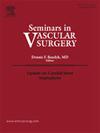A scoping review of limb preservation interventions with primary care providers caring for US Indigenous patients with diabetes and peripheral artery disease
IF 2.4
3区 医学
Q1 PERIPHERAL VASCULAR DISEASE
引用次数: 0
Abstract
Amputation disparities due to diabetes and peripheral artery disease occur among vulnerable and historically mistreated populations. In Oklahoma, some of the highest amputation rates occur in Indigenous residents. Knowing that primary care providers are often the first to tackle prevention and assess at-risk limbs, we sought to understand the historical efforts made by primary care providers in this high-risk population. This scoping review evaluates the literature to summarize prior amputation prevention interventions and their characteristics, including the outcome metrics used among Indigenous populations in the United States. We searched MEDLINE using a combination of Medical Subject Headings and keywords related to amputation, limb preservation, limb salvage, and American Indian and Indigenous health inequities or disparities and ethnicity. We conducted our final search on October 4, 2024, including articles in English and those that focused on primary care practice-based interventions. We excluded case reports, trauma- or oncologic-related amputations, or articles describing interventions not conducted in the United States. We identified 404 articles and 3 fit the review criteria. All interventions were analyses of programs to improve diabetes care. All interventions occurred between 1986 and 2001 and were multilevel in structure. Intervention strategies used included expanded infrastructure, provider and patient education, implementation of clinical workflow and provider metrics, community awareness projects, foot-care expertise and footwear, and field visits. No interventions specifically targeted peripheral artery disease. This scoping review identifies a significant contemporary gap in amputation reduction interventions among Indigenous populations in the United States and highlights multiple areas where interventions may be needed to combat ongoing amputation disparities for a high-risk population.
对美国土著糖尿病和外周动脉疾病患者的初级保健提供者的肢体保留干预措施的范围审查
由于糖尿病和外周动脉疾病导致的截肢差异发生在脆弱和历史上被虐待的人群中。在俄克拉荷马州,一些最高的截肢率发生在土著居民身上。了解到初级保健提供者通常是第一个解决预防和评估危险肢体的人,我们试图了解初级保健提供者在这一高危人群中所做的历史努力。本综述评估了文献,总结了先前的截肢预防干预措施及其特点,包括在美国土著人口中使用的结果指标。我们结合医学主题标题和与截肢、肢体保存、肢体保留、美洲印第安人和土著居民健康不平等或差异和种族相关的关键词搜索MEDLINE。我们在2024年10月4日进行了最后的搜索,包括英语文章和那些专注于初级保健实践干预的文章。我们排除了病例报告,创伤或肿瘤相关截肢,或描述非在美国实施的干预措施的文章。我们确定了404篇文章,其中3篇符合评审标准。所有的干预都是对改善糖尿病护理项目的分析。所有干预都发生在1986年至2001年之间,并且是多层次的结构。所采用的干预策略包括扩大基础设施、提供者和患者教育、实施临床工作流程和提供者指标、社区意识项目、足部护理专业知识和鞋类以及实地访问。没有针对外周动脉疾病的干预措施。本综述确定了当代美国土著人群在截肢减少干预方面的重大差距,并强调了可能需要干预的多个领域,以消除高风险人群持续存在的截肢差异。
本文章由计算机程序翻译,如有差异,请以英文原文为准。
求助全文
约1分钟内获得全文
求助全文
来源期刊
CiteScore
3.50
自引率
4.00%
发文量
54
审稿时长
50 days
期刊介绍:
Each issue of Seminars in Vascular Surgery examines the latest thinking on a particular clinical problem and features new diagnostic and operative techniques. The journal allows practitioners to expand their capabilities and to keep pace with the most rapidly evolving areas of surgery.

 求助内容:
求助内容: 应助结果提醒方式:
应助结果提醒方式:


